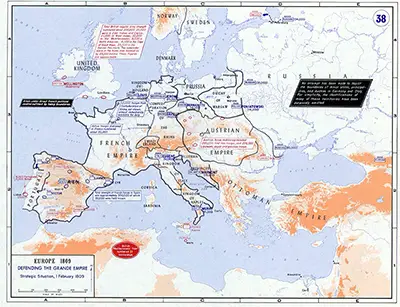The War of the Fifth Coalition
The War of the Fifth Coalition was a short conflict, lasting less than a year and pitting Austria and the United Kingdom against France in 1809. 
French forces had been bogged down in Spain ever since Emperor Napoleon Bonaparte had overthrown the Spanish monarch and installed his own brother as King of Spain, in March 1808. The massing of French troops had officially been part of a joint Franco-Spanish operation to conquer and divide Portugal, but Bonaparte changed the terms of the agreement and then found a very, very determined Spanish population who didn't appreciate the change in plans. Bonaparte himself led a reinforcement of 200,000 troops into Spain in the second half of 1808. The French counter was so successful that all U.K. troops had left not only Spain but also Portugal after the Battle of Corunna, in January 1809. Bonaparte was in Paris, not long returned from Spain, when he heard of a surprise Austrian attack. Bonaparte had negotiated an agreement with Tsar Alexander of Russia, at the Congress of Erfurt in 1808. Russia had agreed to fight with France if it faced another war against Austria. The Austrian army, full of new recruits as a result of a recent mass conscription, smashed their way into Bavaria on April 10, 1809. That was one part of the plan. The other was to invade Italy, which the Austrians did under Archduke John. The French under Prince Eugéne had little trouble sending the Austrian force back out of northern Italy. The Austrians initially suffered defeat, in the Duchy of Warsaw, on April 19 and then, after a well timed counterattack by France that included a victory at Echmühl, withdrew from Bavaria. Bonaparte launched a swift attack across the Danube but was As a result of this treaty, Napoleon found it easier to marry again, to Marie Louise, the daughter of the Austrian emperor. He had divorced his first wife, Josephine, in late 1809. |
|
Social Studies for Kids
copyright 2002–2024
David White



 stymied at Aspern-Essling, on May 22. Austrian forces did not follow up with any sort of significant moves, allowing Bonaparte to seize the initiative. French troops won the Battle of Wagram, in July, followed that up with another victory (at Znaim), and then occupied Vienna, for the second time in recent memory. Austria's defeats left it in a very vulnerable position, and its leaders were forced to agree to the terms of the Treaty of Schönbrunn, on October 14. Among those terms were requirements for Austria to join the
stymied at Aspern-Essling, on May 22. Austrian forces did not follow up with any sort of significant moves, allowing Bonaparte to seize the initiative. French troops won the Battle of Wagram, in July, followed that up with another victory (at Znaim), and then occupied Vienna, for the second time in recent memory. Austria's defeats left it in a very vulnerable position, and its leaders were forced to agree to the terms of the Treaty of Schönbrunn, on October 14. Among those terms were requirements for Austria to join the 
